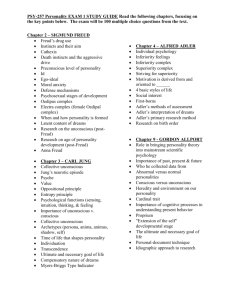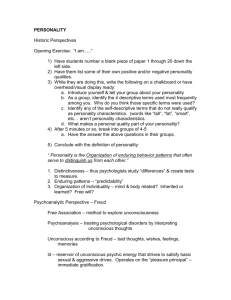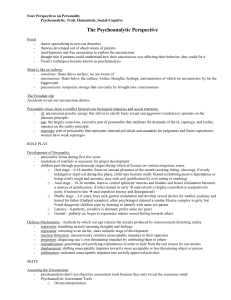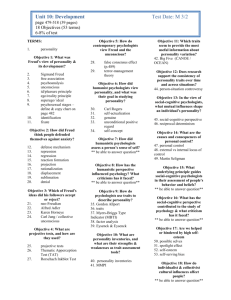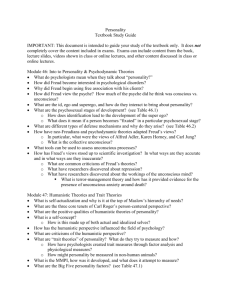assessment techniques
advertisement
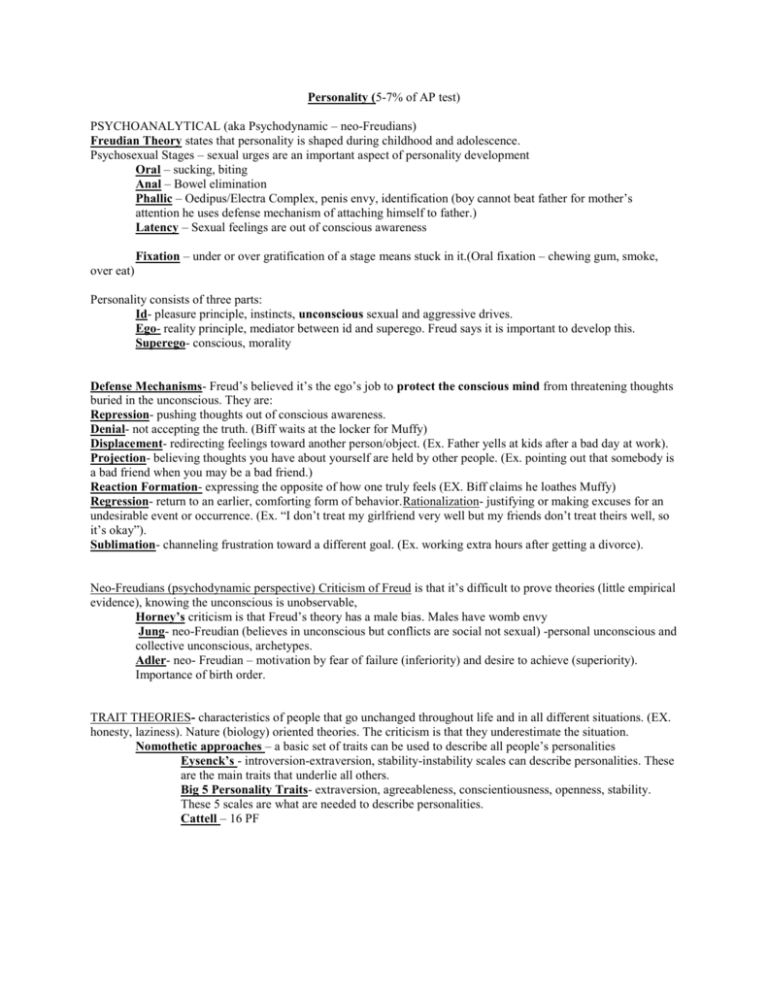
Personality (5-7% of AP test) PSYCHOANALYTICAL (aka Psychodynamic – neo-Freudians) Freudian Theory states that personality is shaped during childhood and adolescence. Psychosexual Stages – sexual urges are an important aspect of personality development Oral – sucking, biting Anal – Bowel elimination Phallic – Oedipus/Electra Complex, penis envy, identification (boy cannot beat father for mother’s attention he uses defense mechanism of attaching himself to father.) Latency – Sexual feelings are out of conscious awareness Fixation – under or over gratification of a stage means stuck in it.(Oral fixation – chewing gum, smoke, over eat) Personality consists of three parts: Id- pleasure principle, instincts, unconscious sexual and aggressive drives. Ego- reality principle, mediator between id and superego. Freud says it is important to develop this. Superego- conscious, morality Defense Mechanisms- Freud’s believed it’s the ego’s job to protect the conscious mind from threatening thoughts buried in the unconscious. They are: Repression- pushing thoughts out of conscious awareness. Denial- not accepting the truth. (Biff waits at the locker for Muffy) Displacement- redirecting feelings toward another person/object. (Ex. Father yells at kids after a bad day at work). Projection- believing thoughts you have about yourself are held by other people. (Ex. pointing out that somebody is a bad friend when you may be a bad friend.) Reaction Formation- expressing the opposite of how one truly feels (EX. Biff claims he loathes Muffy) Regression- return to an earlier, comforting form of behavior.Rationalization- justifying or making excuses for an undesirable event or occurrence. (Ex. “I don’t treat my girlfriend very well but my friends don’t treat theirs well, so it’s okay”). Sublimation- channeling frustration toward a different goal. (Ex. working extra hours after getting a divorce). Neo-Freudians (psychodynamic perspective) Criticism of Freud is that it’s difficult to prove theories (little empirical evidence), knowing the unconscious is unobservable, Horney’s criticism is that Freud’s theory has a male bias. Males have womb envy Jung- neo-Freudian (believes in unconscious but conflicts are social not sexual) -personal unconscious and collective unconscious, archetypes. Adler- neo- Freudian – motivation by fear of failure (inferiority) and desire to achieve (superiority). Importance of birth order. TRAIT THEORIES- characteristics of people that go unchanged throughout life and in all different situations. (EX. honesty, laziness). Nature (biology) oriented theories. The criticism is that they underestimate the situation. Nomothetic approaches – a basic set of traits can be used to describe all people’s personalities Eysenck’s - introversion-extraversion, stability-instability scales can describe personalities. These are the main traits that underlie all others. Big 5 Personality Traits- extraversion, agreeableness, conscientiousness, openness, stability. These 5 scales are what are needed to describe personalities. Cattell – 16 PF Idiographic Approach all humans have unique personalities and cannot be described in generalizations. – Gordon Allport. He believed cardinal dispositions are the traits that have the greatest influence. BIOLOGICAL THEORIES- personality determined by genes, chemistry. EX- temperament- emotional style of dealing with world/others such as getting angry easily. Heritability- measure of the percentage of a trait that is inherited. Temperament – a personas emotional style and characteristic way of dealing with the world Somatotype Theory (Sheldon) – three body types associated with personality traits (mesomorphs .etc) BEHAVIORIST THEORY- personality determined by environment, reinforcers SOCIAL – COGNITIVE THEORY- (Bandura) personality determined by the environment and patterns of thought (the way we interpret events) Reciprocal determinism (aka triadic reciprocality) – interaction between traits, environment and person’s behavior. 3 factors influence one another in a looplike fashion ] Self-efficacy – if you are optimistic about your own ability to get things done, low self efficacy = powerless Internal and External locus of control. The belief someone has as to how much control of their destiny they have. Internals believe if they work hard they will succeed. Learned Helplessness- the belief that some people get (because of bad uncontrollable events) that says they cannot help themselves to create or get out of unpleasant circumstances. HUMANISTIC THEORYPeople are innately good and have free will (people control own destiny). Self- actualization Maslow (people are motivated to reach full potential and grow) Unconditional positive regard by Rogers (accepting someone no matter what) creates an environment that allows someone to develop a self-concept. Individualistic cultures (United States- where the focus is on the self, making own decisions) vs. Collectivist cultures (Japan- where the emphasis is on doing what the community wants). ASSESSMENT TECHNIQUES Psychoanalytic Projective Tests- purpose is to reveal the unconscious (TAT) Thematic Apperception Test- people given a picture and asked to say what is happening in the picture Rorschach inkblot- people given a picture of an inkblot and asked to state everything they see in it. Personality Inventories- MMPI- (self report inventory) Minnesota Multiphasic Personality Inventory- most widely used self-report. Barnum effect- susceptibility of people to be deceived when reports show vague, general and usually positive assessments of individuals. Astrologers, psychics exploit this. Positive Psychology- Seligman’s idea that happy people need to be studied more because they have certain thought patterns, lifestyles that lead to happiness. EX. Correlational studies showing how optimistic people live longer lives.



